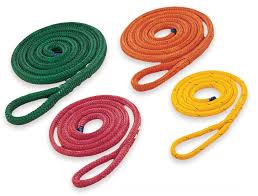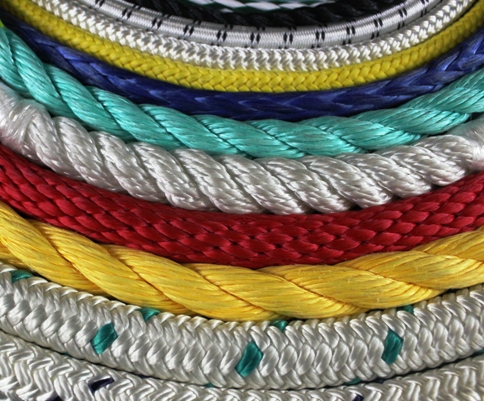
Contents
Sling – Natural and Synthetic fiber rope sling
Natural and synthetic fiber rope slings are used primarily for temporary work, such as construction and painting jobs, and in marine operations. Fiber rope slings are pliant, grip loads well, and do not mar the surface of the load.
The most common constructions for fiber rope slings are 3-strand laid, 8-strand plaited, and hollow braided nylon and polyester. Fiber rope slings have the following properties in common:

- Strength,
- Safety,
- Convenience,
- Load protection,
- Long life,
- Economy,
- Shock absorbency, and
- Temperature resistance.
Identification:
New slings are marked by the manufacture to show:
- The rated load for the types of hitches, and the angle upon which they are based,
- The name or trademark of the manufacturer,
- The manufacturer’s code or stock number, and
- The type of material and construction.
Rated loads:
Rated loads (capacities) for single-leg vertical, choker, and basket hitches are as shown in Tables 18 through 20.
For angles not shown, use the next lower angle or a qualified person to calculate the rated load. Rated loads are based on:
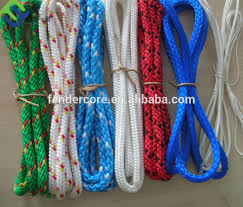
- Material strength,
- Design factor
- Type of hitch (see Fig. 5),
- Angle of loading (see Fig. 3), and
- Diameter of curvature over which the sling is used (D/d) (see Fig. 6).
Do not use horizontal angles less than 30 degrees except as recommended by the sling manufacturer or a qualified person.
The rated load for a sling in a choker hitch is the value in Tables 18 through 20, provided that the angle of the choke is 120 degrees or more. For angles of choke less than 120 degrees, use the rated loads provided by the sling manufacturer or a qualified person.
For other synthetic materials and for configurations not shown, use the rated loads provided by the sling manufacturer or a qualified person.
Fig-3
Fig-5
End attachments:
Ensure that mechanical fittings used as part of a synthetic sling meet the following:
- Materials are compatible with the mechanical and environmental requirements of the sling,
- A qualified person verifies the suitability of mechanical or socketed fittings,
- Fittings have sufficient strength to sustain twice the rated load of the sling,
- Surfaces are clean and sharp edges are removed,
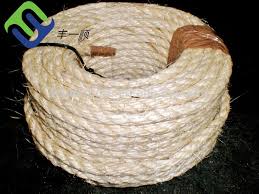
- Used, repaired, or welded fittings are proof tested to twice the rated load,
- Aluminum fittings are not used where fumes, vapors, sprays, mists, or liquids of alkalies or acids are present,
- Fitting openings have the proper shape and size to ensure that the fitting will seat properly,
- Thimbles are used in the sling whenever possible,
- Thimbles have closed ears to prevent them from falling out or rotating inside the eye, and
- Thimbles have a diameter at the bearing surface of at least twice the rope diameter.
Splicing:
Ensure that spliced synthetic fiber rope slings have been spliced in accordance with the following minimum requirements, and in addition to any recommendations of the manufacturer:
- For tuck splices in three- and eight-strand synthetic ropes, no less than four full tucks are used. Short splices contain at least eight full tucks, four on each side of the center splice,
- In manila rope, eye splices consist of at least three full tucks, and short splices consist of at least six full tucks, three on each side of the splice center line,
- Strand-end tails in all tuck splices are not trimmed short, and
- Synthetic rope slings have a minimum length of ten times the rope diameter between the last tuck of tuck splices or between the ends of the buried tails or strands of other types of splices. The diameter and width of the bearing surface of the fitting can affect the strength of the sling. Follow the sling manufacturer’s recommendations when fittings are used with the sling. Do not use knots, clips, or clamps to fabricate slings. If thimbles do not have ears, lash the thimbles to the rope to prevent rotation.
Table 18
Nylon Rope Slings
Based on Design Factor = 5 and Rated Loads Expressed in pounds (lb)
GENERAL NOTES:
(a) See Fig. 8 for sling types, Fig. 5 for hitch types, and Fig. 3 for sling angle descriptions. For D/d considerations see note in Fig. 5.
(b) For choker hitch, the angle of choke is 120 deg or greater.
Table 20
Polypropylene Rope Slings
Based on Design Factor = 5 and Rated Loads Expressed in pounds (lb)
GENERAL NOTES:
(a) See Fig. 8 for sling types, Fig. 5 for hitch types, and Fig. 3 for sling angle descriptions. For D/d considerations see note in Fig. 5.
(b) For choker hitch, the angle of choke is 120 deg or greater.
Inspections:
Designate a qualified person to inspect slings and all fastenings and attachments each day before use for damage or defects.
This qualified person also performs additional periodic inspections where service conditions warrant, as determined on the basis of:
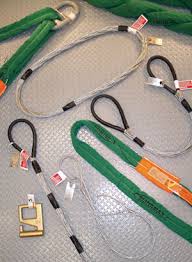
- Frequency of sling use,
- Severity of service conditions,
- Nature of lifts being made, and
- Experience gained during the service life of slings used in similar circumstances.
Make periodic inspections of natural and synthetic fiber rope slings at intervals no greater than 12 months. A good guide to follow includes:
- Yearly for normal service use,
- Monthly to quarterly for severe service use, and
- As recommended by a qualified person for special and infrequent service use.
Although OSHA’s sling standard does not require you to make and maintain records of inspections, the ASME standard contains provisions on inspection records.
Make a thorough inspection of slings and attachments. Items to look for include:
- Missing or illegible sling identifications,
- Cuts, gouges, areas of extensive fiber breakage along the length and abraded areas on the rope,
- Damage of 10 percent or more of the ropes diameter,
- Uniform fiber breakage along the major part of the length of the rope in the sling such that the entire rope appears covered with fuzz or whiskers,
- Fiber breakage or melted fiber inside the rope that appears along the length at the same relative position and involves damage estimated at 10 percent of the fiber in the strand at that point,
- Discoloration and brittle or stiff areas on any part of the sling,
- Excessive dirt and grit in the interior of the rope structure,
- Foreign matter that has permeated the rope and attracts and holds grit,
- Kinks, distortion, or other damage in the rope structure,
- Melted or charred areas that affect more than 10 percent of the diameter of the rope or affect several adjacent strands along the length to more than 10 percent of their individual diameters.
- Poor condition of thimbles or other fittings manifested by corrosion, cracks, distortion, or localized wear, and
- Other conditions that cause doubt as to continued use of the sling.
Where any such defect or deterioration is present, remove the sling or attachment from service immediately.
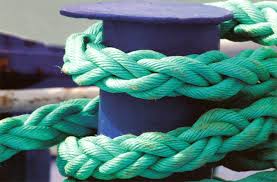
Repairing/Reconditioning:
Do not use worn or damaged slings or attachments. Do not use repaired or reconditioned fiber rope slings. Do not use old or used rope to make up a fiber rope sling.
Modifications or alterations to end attachments or fittings are considered a repair.
Operating practices:
Ensure that natural and synthetic fiber rope slings have suitable characteristics for the type of load, hitch, and environment in which they will be used and that they are not used with loads in excess of the rated load capacities described in the appropriate tables. Follow other safe operating practices, including:
Sling Selection:
- For multiple-leg slings used with non symmetrical loads, ensure that an analysis by a qualified person is performed to prevent overloading of any leg,
- Ensure that multiple-leg slings are selected according to Tables 18 through 20 when used at the specific angles given in the table. Ensure that operation at other angles is limited to rated loads of the next lower angle given in the table or calculated by a qualified person,
- When D/d ratios (see Fig. 6) smaller than those cited in Fig. 5 are necessary, ensure that the rated load of the sling is decreased. Consult the sling manufacturer or a qualified person, and
- Do not use a component unless it is of the proper shape and size to ensure that it is properly seated in the hook or lifting device.
Cautions to Personnel
- Ensure that all portions of the human body are kept away from the area between the sling and the load and between the sling and the crane or hoist hook,
- Ensure that personnel never stand in line with or next to the legs of a sling that is under tension,
- Ensure that personnel do not stand or pass under a suspended load,
- Ensure that personnel do not ride the sling or the load, unless the load is specifically designed and tested for carrying personnel, and
- Do not use synthetic rope slings as bridles on suspended personnel platforms.
Effects of Environment:
- Store slings in an area where they will not be subjected to mechanical, chemical, or ultraviolet damage, or to extreme temperatures,
- When slings are exposed to extreme temperatures, follow the guidance provided by the sling manufacturer or qualified person.
- Do not store fiber ropes in areas where they may become impregnated with rust, and
- Ensure that slings exposed to salt water are thoroughly rinsed with fresh water to prevent mechanical damage from salt crystals when the rope dries.
Rigging Practices
- Ensure that slings are hitched in a manner providing control of the load,
- Ensure that sharp edges in contact with slings are padded with material of sufficient strength to protect the sling,
- Ensure that slings are shortened or adjusted only by methods approved by the sling manufacturer or a qualified person,
- Ensure that, during lifting with or without a load, personnel are alert for possible snagging,
- Ensure that, in a basket hitch, the load is balanced to prevent slippage,
- When using a basket hitch, ensure that the legs of the sling contain or support the load from the sides, above the center of gravity, so that the load remains under control,
- Ensure that, in a choker hitch, the choke point is only on the sling body, never on a splice or fitting,
- Ensure that, in a choker hitch, an angle of choke less than 120 degrees is not used without reducing the rated load,
- Ensure that slings are not constricted, bunched, or pinched by the load, hook, or any fitting,
- Ensure that the load applied to the hook is centered in the base (bowl) of the hook to prevent point loading on the hook, unless the hook is designed for point loading,
- Ensure that an object in the eye of a sling is not wider than one-third the length of the eye,
- Ensure that the sling and the load are not allowed to rotate when hand-tucked slings are used in a single-leg vertical lift application. Ensure that care is taken to minimize sling rotation.
- Do not shorten or lengthen a sling by knotting or twisting,
- Do not rest loads on the sling,
- Do not pull a sling from under a load when the load is resting on the sling,
- Do not drag slings on the floor or over abrasive surfaces,
- Do not allow shock loading, and
- Avoid twisting and kinking.
Proof testing:
Before initial use, ensure that all new natural and synthetic fiber rope slings incorporating previously used or welded fittings and all repaired slings are proof tested by the manufacturer or a qualified person.
Other new natural and synthetic fiber rope slings need not be proof tested, although the employer may require proof testing in purchasing specifications.
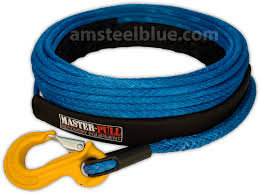
Environmental effects:
Temperature
Do not allow natural and synthetic fiber rope slings to be used in contact with objects or at temperatures in excess of 194 degrees F (90 degrees C), or below minus 40 degrees F (minus 40 degrees C).
Some synthetic yarns do not retain their breaking strength during long-term exposure above 140 degrees (60 degrees C). Consult the sling manufacturer for the effects of long-term heat exposure.
Sunlight & Ultraviolet
Long-term exposure to sunlight or ultraviolet radiation can affect the strength of natural, nylon and polyester rope slings. Consult the sling manufacturer for proper retirement criteria for nylon and polyester ropes subjected to long-term storage or use in sunlight.
Chemical
Chemically active environments can affect the strength of natural and synthetic fiber rope slings. Consult the manufacturer before using a sling in such environments. Also, the presence of rust in wet nylon ropes has been found to be potentially harmful.
Click the below link to download the check sheet for natural and synthetic web sling

